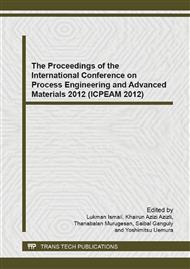[1]
S. Himeno, T. Komatsu, and S. Fujita, (2005). High- pressure adsorption equilibria of methane and carbon dioxide on several activated carbons. J. of Chemical Engineering Data, pg 369-376.
DOI: 10.1021/je049786x
Google Scholar
[2]
Martunus, Z. Helwani, A.D. Wiheeb, and M.R. Othman, (2012). Improved Carbon Dioxide Capture using Metal Reinforced Hydrotalcite under Wet Conditions. J. of Greenhouse Gas Control, pg 127-136.
DOI: 10.1016/j.ijggc.2012.01.007
Google Scholar
[3]
H. Jens, M.K. Hanne, H. Geir, M. Fredrik, K. Vemund, and T. Goran, (2009). Integrating a full carbon capture scheme onto a 450 MW NGCC electric power generation hub for offshore operation. J. of Applied Energy, pg 2298-2307.
DOI: 10.1016/j.apenergy.2009.03.019
Google Scholar
[4]
B. Giuseppe, B. Patrizia, C. Angela, M. Roberto, P. Paolo, R. Caterina, and T. Marco, (2011). Silica aluminas for carbon dioxide bulk removal from sour natural gas. J. Microporous and Mesoporous Materials, pg 134-140.
DOI: 10.1016/j.micromeso.2011.04.038
Google Scholar
[5]
M.A. Rolando and Roque-Malherbe, (2007). Adsorption and Diffusion in Nanoporous Materials, CRC press, 1 edition.
Google Scholar
[6]
Q. Xue, D. Wu, Y. Zhou, and I. Zhou, (2012). Improvement of amine modification with piperazine for the adsorption of CO2. J. of Applied Surface Science, pg 3859- 3863.
DOI: 10.1016/j.apsusc.2011.12.046
Google Scholar
[7]
William Echt and Peter Meister, (2009). Design, fabrication and startup of and offshore membrane CO2 removal system. 88th Annual Convention, March 8-11, Gas Processors Association.
Google Scholar
[8]
J. Wei, Lei Liao., X. Yu, Z. Pei, and S. Yao, (2010). Capture of carbon dioxide by amine- impregnated as- synthesized MCM- 41, J. of Environmental Sciences, pg 1558- 1563.
DOI: 10.1016/s1001-0742(09)60289-8
Google Scholar
[9]
R.V. Siriwardane, M.S. Shen, and P. Edward (2003). Adsorption of CO2, N2, and O2 on Natural Zeolites. J. of Energy & Fuels, pg 571-576.
Google Scholar
[10]
Y. Han-Kyol, Jun Kim, C. Govindasamy, J. Hangkyo, and A. Wha-Seung, (2011). High pressure carbon dioxide adsorption on nanoporous carbon prepared by zeolite Y templating. J. of Material Letters, pg 1772- 1774.
DOI: 10.1016/j.matlet.2011.03.039
Google Scholar
[11]
X. Xu, C. Song, J.M. Andresen, B.G. Miller, and A.W. Scaroni, (2002). Novel polyethylenimine- modified mesoporous molecular sieve of MCM-41 type as high- capacity adsorbent for CO2 capture, J. of Energy & Fuels, pg 1463-1469.
DOI: 10.1021/ef020058u
Google Scholar
[12]
H.U. Zhihui, Zhang Donghui and Wang Jixiao, (2011). Direct synthesis of amine- functionalized mesoporous silica for CO2 adsorption. Chinese Journal of Chemical Engineering, pg 386-390.
DOI: 10.1016/s1004-9541(09)60225-1
Google Scholar
[13]
V. Zelenak, D. Halamova, L. E. Gaberova Bloch and P. Llewellyn (2008).
Google Scholar
[14]
P. Sharma, S. Jun Kyong, Yun-Ho, Jung, C. Su-Hyun, and Sang-Do Park, (2012).
Google Scholar
[15]
S. Won-Jin, Ch. Jung-Sik and A. Wha-Seung, (2008). Adsorptive removal of carbon dioxide using polyethyleneimine-loaded mesoporous silica materials. J. of Microporous and Mesoporous Material, pg 31-40.
DOI: 10.1016/j.micromeso.2007.10.049
Google Scholar
[16]
S.M.L. Hardie, M.H. Garnetti, A.E. Fallick, A.P. Rowland, (2005). Carbon dioxide capture using zeolite molecular sieve sampling system for isotopic studies. J. of Radiocarbon. pg 441-451.
DOI: 10.1017/s0033822200035220
Google Scholar
[17]
Marco Tagliabue, Caterina Rizzo, B. Nicola Onorati, F. Enrico Gambarotta, Angela Carati, Francesca Bazzano, (2012). Regenerability of zeolites as adsorbents for natural gas sweetening: A case-study. Fuel Vol93 238–244.
DOI: 10.1016/j.fuel.2011.08.051
Google Scholar
[18]
T.J. Barton, L.M. Bull, W.G. Klemperer, D.A. Loy, B. McEnaney, M. Misono, P.A. Monson, G. Pez, G.W. Scherer, J.C. Vartuli, and O.M. Yaghi, (1999). Tailored Porous Materials, J. of Chemical Material, pg 2633-2656.
DOI: 10.1021/cm9805929
Google Scholar
[19]
Youssef Belmabkhout, Rodrigo Serna-Guerrero, Abdelhamid Sayari, (2009). Adsorption of CO2 from dry gas on MCM-41 silica at ambient temperature and high pressure: pure CO2 adsorption. J. of Chemical Engineering, pg 3721- 3728.
DOI: 10.1016/j.ces.2009.05.039
Google Scholar
[20]
A. Dabrowski, (2001). Adsorption from theory to practice. J. of Advance Colloid Interface Science, pg 135-224.
Google Scholar
[21]
F. Gritti, G. Gotmar, B.J. Stanley, and G. Guichon, (2003). Determination of single component isotherm and affinity energy distribution by chromatography. J. of Chromatography, pg 185-203.
DOI: 10.1016/s0021-9673(02)02084-8
Google Scholar


